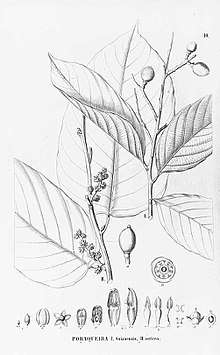Poraqueiba sericea
Poraqueiba sericea (common name: umari) is a species of tree in the family Metteniusaceae. It is native to South America.[1]
| Poraqueiba sericea | |
|---|---|
 | |
| Branchlets of Poraqueiba sericea (left) and Poraqueiba guianensis (right) | |
| Scientific classification | |
| Kingdom: | Plantae |
| Clade: | Tracheophytes |
| Clade: | Angiosperms |
| Clade: | Eudicots |
| Clade: | Asterids |
| Order: | Metteniusales |
| Family: | Metteniusaceae |
| Genus: | Poraqueiba |
| Species: | P. sericea |
| Binomial name | |
| Poraqueiba sericea Tul. | |
| Synonyms | |
|
Poraqueiba acuminata Miers | |
Description
P. sericea trees grow up to 30 m tall and 60 cm dbh.[2] Bark somewhat smooth or rough, dark brown or slightly purple.[2] Leaves broadly elliptic-ovate, coriaceous, 17–24 cm long, 8–15 cm wide, apex acuminate, base rounded.[2] Inflorescence a terminal or axillary panicle, 5–10 cm long, flowers with ovate lanceolate petals 0.3-0.4 mm long.[2][3] The fruit is a smooth ovoid-oblong drupe, 5–10 cm long, 4–6 cm wide; it can be yellowish green, orange, dark purple or black when mature.[2][3]
Distribution and habitat
P. sericea is found in the western and central Amazon rainforest in Venezuela, Colombia, Peru and Brazil.[1][2][3]
Uses
The fruit is edible, but the taste may not be good for people unfamiliar with the fruit.[3]
The wood is of medium or somewhat coarse texture; heavy, compact and durable.[4] It is used for carpentry and fuel.[4]
References
- Grandtner, M. M.; Chevrette, Julien (2013). Dictionary of Trees, Volume 2: South America: Nomenclature, Taxonomy and Ecology. Academic Press. p. 518. ISBN 9780123969545.
- Francis, Macbride, J. (1951). "Flora of Peru". Fieldiana. v.13:pt.3A:no.1: 230.
- Food and Fruit-bearing Forest Species: Examples from Latin America. FAO. 1986. p. 221. ISBN 9789251023723.
- Williams, L. (1936). "Woods of northeastern Peru,". Field Museum Botanical Series. 15: 291.